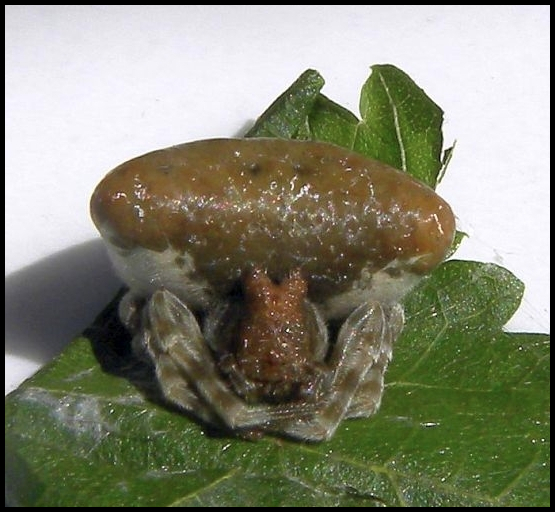
The idea is that the rocks or other weights on the ends of joined lines spread out when the twirling bolas are thrown; when one of the lines strikes an animal or its leg, all the spinning weights will quickly wrap around the target, thus felling livestock…and subduing or killing small game.
Now, bolas spiders are morphologically and genetically members of the family Araneidae, which spiders are called “orb weavers” because they usually make those stereotypical orb webs so well known to all. (See this 2016 post for some of my prolix ramblings about orb webs.) Bolas araneid spiders, though, make no capture webs, being instead nocturnal hunters: They are, therefore, easily overlooked as they tend to remain motionless during the day, trying very hard to look like bird droppings or buds on twigs.

Copyrighted photo by, and used with permission of, Jim Eckert
jeckert49@juno.com
While these non-orb-weaving orb weavers make no web, they do use sticky silk to ensnare prey, and, as you no doubt have sussed out, they do this in a manner reminiscent of the gauchos’ bolas.
While the technique varies somewhat among the more than 50 species of bolas spiders, a general description of what a bolas spider does is to make a single strand of silk having a large glob of stickum (more, in some species) on its end. The spider dangles this sole line from its perch and waits for a flying insect to appear, and then swings its sticky bola at it, or–depending on the species–it may swing the bola constantly, increasing the chances of its randomly making contact with a suitable supper.

Photo from Wikipedia
Once a hapless insect is stuck to the line’s end, it is hauled up to be dispatched and eaten in normal spider fashion.
Cool, eh? But the very best part is that these spiders stack the deck in their favor…bolas spider species have evolved the ability to produce pheromone mimics that male moths of particular species detect and respond to as their species’s sex pheromones! Yep, those testosterone-poisoned males follow the pheromone trail right to the spider’s bola.
And, should the spider miss its attempt to snag it, the by now frantically eager male will hang around, still lusting for the consensual “fang fatale” that lured him in, giving our spider protagonist multiple opportunities to catch its meal.
It was ever thus.
